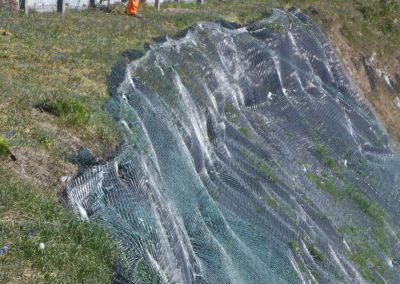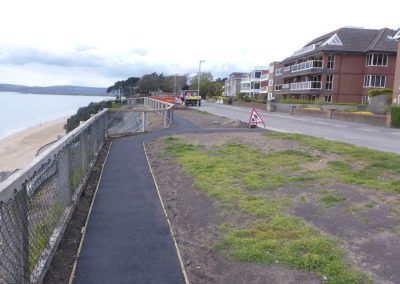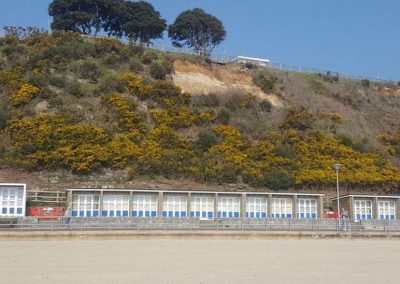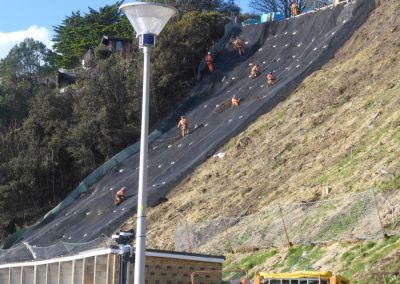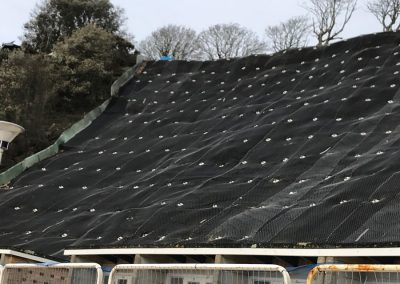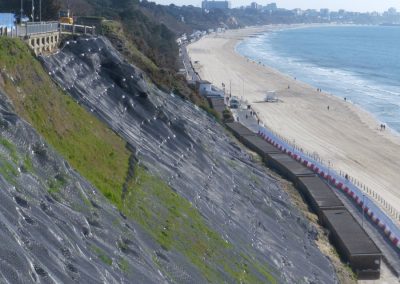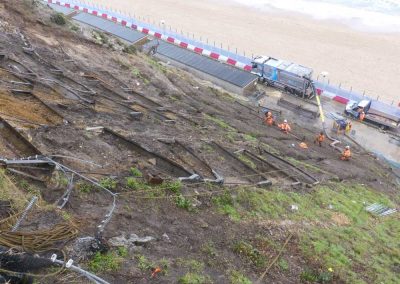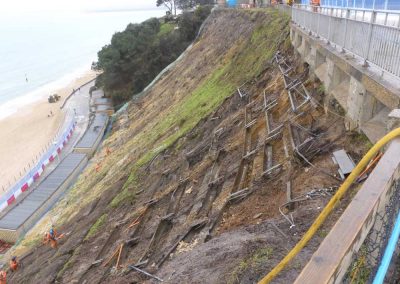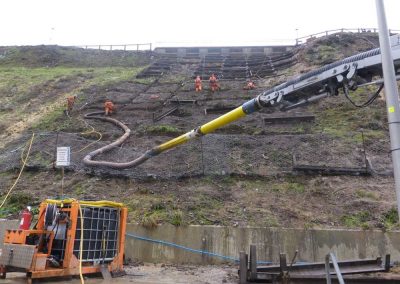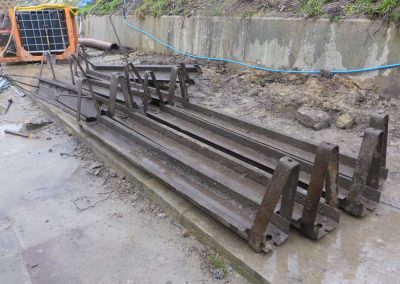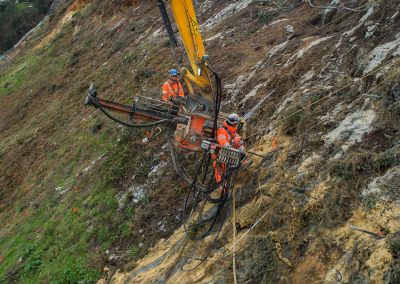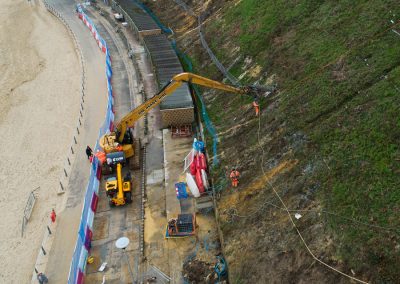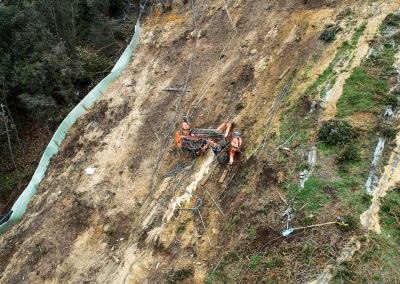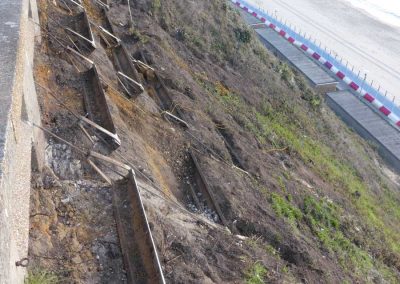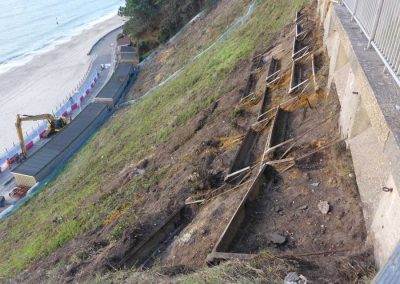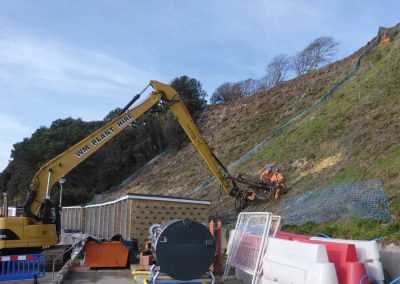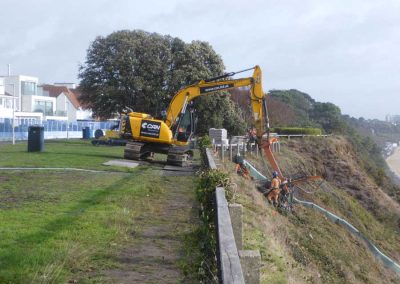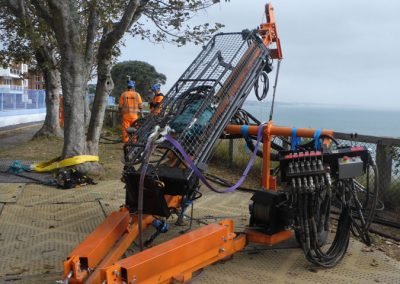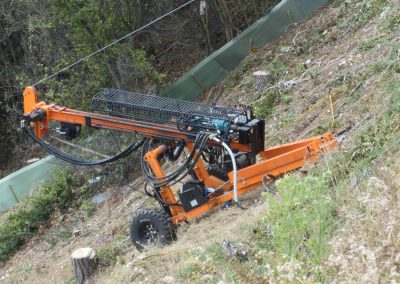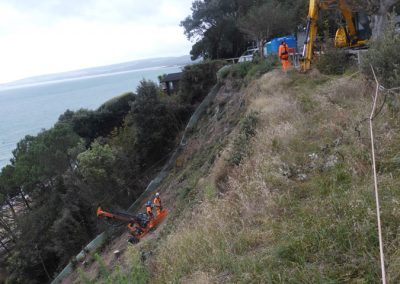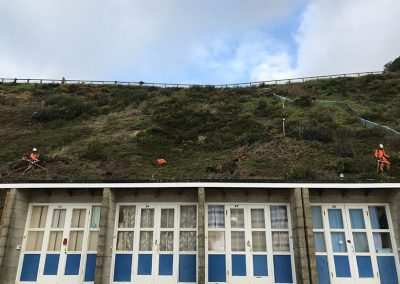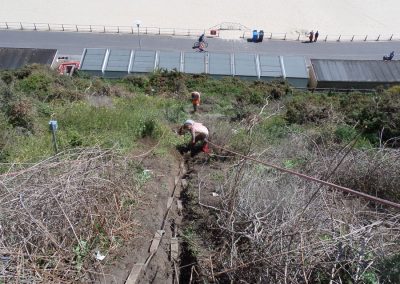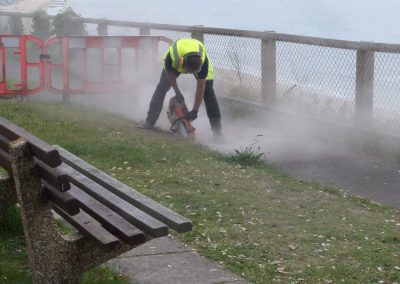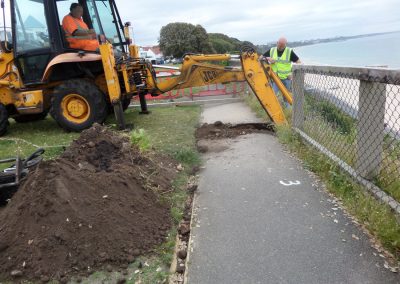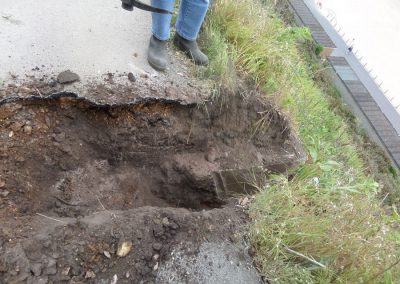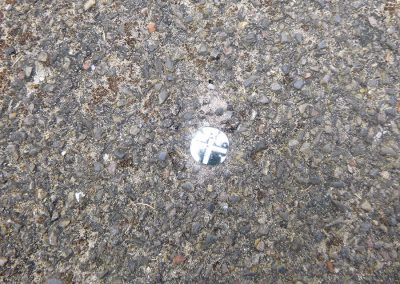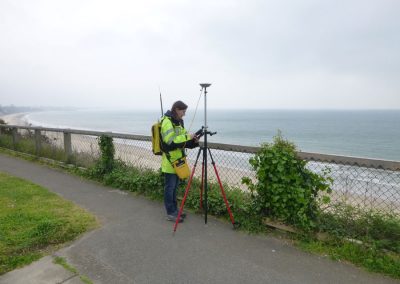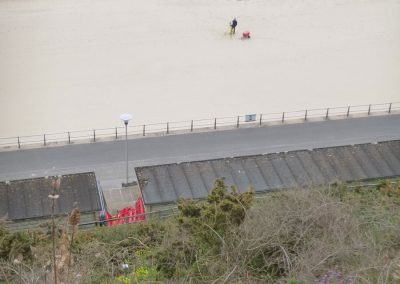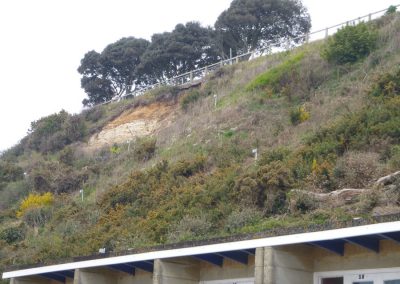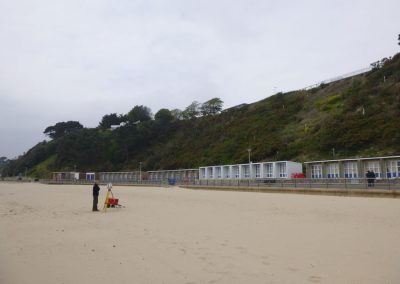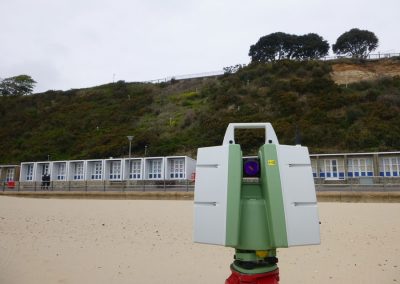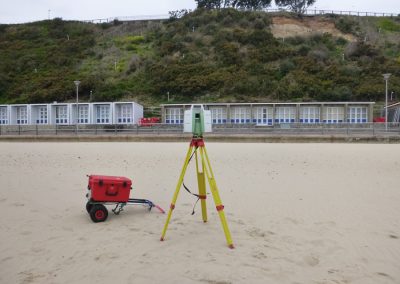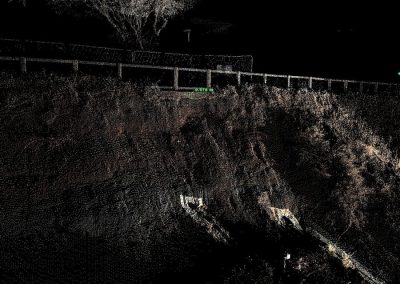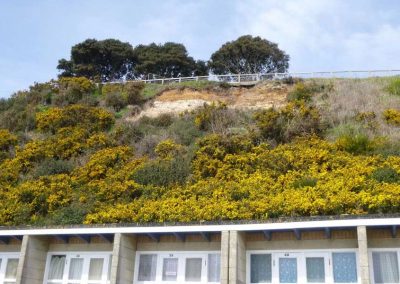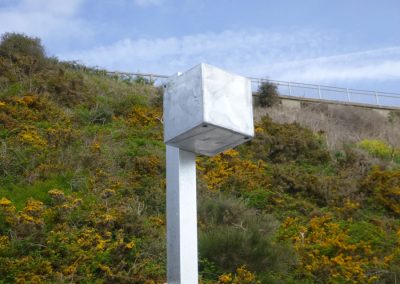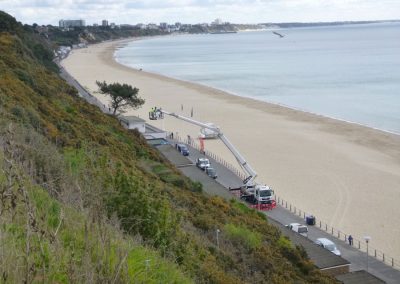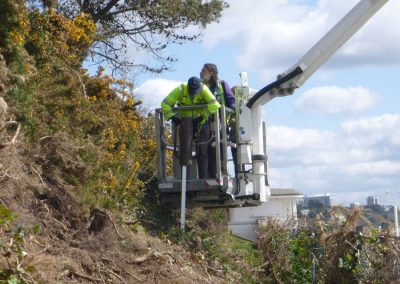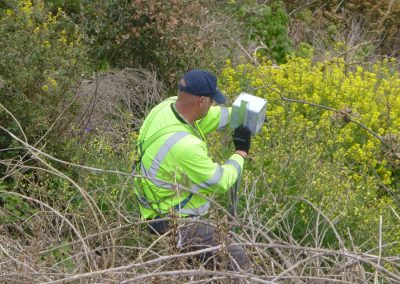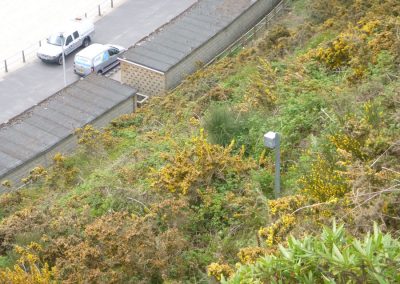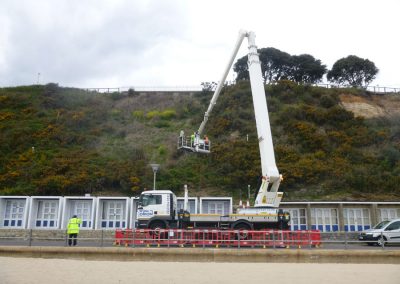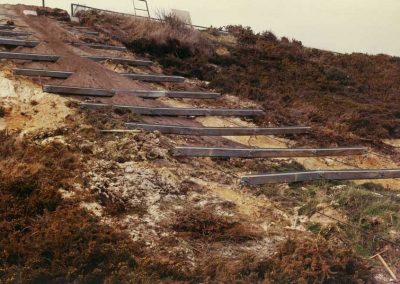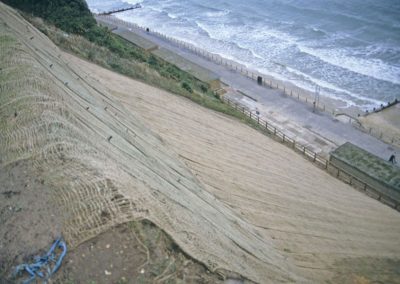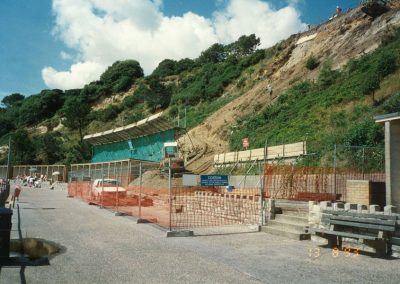Completed Projects
Canford Cliffs Stabilisation Works, 2020-2021
A programme of stabilisation works to address the 2017 landslip below Cliff Drive, Poole.
This scheme supports the £9.5 million investment programme on Poole’s seafront and the plans to convert the Canford Cliffs pavilion into a cafe and refurbish the public toilets and beach huts
LEAD AUTHORITY
BCP Council
WORKING WITH
START DATE
14th September 2000
END DATE
14th May 2021
Project site map, click to enlarge image
Overview
Following an extensive period of planning and monitoring, specialist contractor, CAN Geotechnical were appointed to deliver the £2.5m cliff stabilisation scheme. Work started on 21st September 2020 and was completed a month sooner than anticipated, in early May 2021 – despite the team having to cope with a pandemic and a wide variety of weather conditions.
- Over 1,600 soil nails (up to 15m in length) were used to secure approximately 5,500m² of cliff. This method was previously used here during the 1990s and monitoring has demonstrated the cliff has remained stable (see Historical cliff slips below).
- Long reach excavators were used from the top of the cliff and from the promenade below. Drill rigs were suspended from an anchor system at the top of the embankment.
- A facing system of erosion control matting overlaid with steel netting was installed to help stabilise the soil; the cliff face was then hydro-seeded to support native vegetation and wildlife habitat re-growth.
Work methods and project progress
May 2021 – cliff-top restoration phase
The hydro-seeding is complete, as is work on the clifftop footpath and fencing, with a small route deviation around the location of the 2017 cliff slip. Beach huts closed since the cliff slip in 2017 will be surveyed, spruced up and made ready to welcome back their tenants.
Benches will be returned from their safe storage to the cliff top and prom. The zig-zag path to the beach has been re-opened.
The Cliff Drive vehicle weight restriction, relaxed for the duration of the works, will re-apply as soon as the road is fully re-opened. Damage to the road, kerb and footway is being repaired and the original row of timber bollards will be replaced. Gullies will be repaired and cleaned. Most of the parking spaces are already returned.
April 2021 – cliff-face restoration phase
Having recently been covered in a facing system of erosion protection matting & steel netting (details below), the cliff face is now being hydro-seeded to enable the native vegetation and greenery to re-grow and support the wildlife habitat.
February 2021
In February the cliff face was covered in a facing system comprising erosion protection matting overlaid with a high tensile steel netting. The erosion matting helps to prevent minor local erosion of the slope surface, forming a protective layer to help stabilise the soil enough to promote vegetation re-growth. The high tensile steel netting works in conjunction with the soil nails, being held in position and linked to the soil nails by steel head plates, working together to secure the slope.
January 2021
Showing the vacuum excavator specialist equipment being employed to carefully remove material from the 1970’s Steel Cable & Cross Beam slope stabilisation system works (Area B in the project site map above)
November, soil nail drilling
How the Soil Nails Work
- Soil nails are a method of stabilising steep slopes and cliffs, with each soil nail consisting of a high strength steel bar being inserted deep into the slope in a drilled borehole.
- The soil nail is bonded into the borehole using a high strength mixture of cement and water called grout, which is mixed on site and pumped into each borehole. When the grout sets each soil nail “pins back” a small section of the face, and with 1700 soil nails installed in a regular pattern the entire group of soil nails work together to fully stabilise the cliff.
- High tensile steel netting is installed over the soil nails, and a plate attached to each nail to hold the mesh in position – this prevents material between the soil nails from slipping out and helps the soil nails to work together.
- CAN use a foam flush to pre-drill the borehole before grouting; this avoids excessive grout hardening on the slope – an environmentally friendly method that ensures a cleaner finish.
- The soil nails used at Canford Cliffs are a mixture of 9m and 12m length and are installed in 115mm diameter holes drilled into the face. Installation requires very large heavy-duty drills which are fitted to excavators operating at the top or bottom of the slope, or to special slope climbing drill rigs which can access the slope itself.
- Drilling such a large number of soil nails will take most of the 9-months duration of this project, So far, some difficult ground conditions have been encountered but drilling is progressing well; soil nailing along the bottom of the site is complete and the top nearing completion. With only the middle sections to complete, the project is on course to meet the target end date of Spring 2021.
October, excavating 1970s stabilisation measures and soil nail drilling
22nd September, soil nail testing
Pre-Works
Access on Cliff Drive
A section of Cliff Drive will be closed to vehicles and on-road parking suspended for the duration of the works. These arrangements will help ensure public and contractor safety and protect the special designation afforded to this area, a Site of Nature Conservation Interest.
Access will be maintained for residents, emergency services and construction vehicles only. Pedestrian access to Cliff Drive will also be maintained, although the zig-zag path to the beach will be closed. Flaghead Chine and Canford Cliffs Chine pathways will remain open. Diversions will be in place.
Project background
In February 2017 a section of cliff approximately 10m wide x 0.5m deep eroded and slipped at Canford Cliffs. There was concern the material might travel down to beach level, especially in the event of bad weather. Three blocks of beach huts were temporarily closed for safety reasons, along with a short stretch of undermined footpath on Cliff Drive. The programme of planned investment in new seafront infrastructure and beach huts at Canford Cliffs, due to start in 2017, was postponed. Since then, extensive planning and monitoring of the cliff face has taken place to understand how mobile it is and the best methods to secure it.
Project Preparations
2020
- September 2020 Work contributing to the biodiversity enhancement of Canford Cliffs began with the removal of some non-native Holm Oaks. This is an invasive species that sel-seeds prolifically to the detriment of native heathland vegetation which supports the protected species on the cliff face. They will be replaced with native vegetation which better supports insect life and provides more opportunity for birds to feed.
- August 2020 Traffic Regulation Orders advertised the temporary part-closure of Cliff Drive, including the suspension of the parking bays and the closure of the zig-zag path for the duration of the works. Beach hut tenants were advised on arrangements for accessing and using their beach huts.
- July 2020 Specialist contractor CAN Geotechnical was appointed to deliver the cliff stabilisation scheme. It will involve using soil nails (up to 15m in length) to stabilise the cliff face. The works are planned to minimise disruptionto residents and beach users.
- January 2020 Vegetation was cut back to enable structural engineers to assess the condition of the cliff face and monitor its stability, helping with the final preparations for engineering works to stabilise the cliff. Cutting the vegetation close to ground level allowed wildlife surveys to be completed to ensure all protected reptiles and nesting birds are excluded from the proposed working area. Reptiles were moved to a pre-prepared ‘friendly’ habitat outside the exclusion zone. Once the stabilisation works are complete they will be able to re-colonise the area.
2019
- December 2019 / January 2020 A section of cliff to the east of the 2017 slip moved significantly over the Christmas period. This increased the risk of material piling up at the back of the beach huts which could be of sufficient force to cause a partial collapse of beach huts. Block number 6 was closed (along with Blocks 4 and 5) for safety reasons.
- April 2019 Borehole drilling took place on the promenade and beach hut terraces around block numbers 1–11 (borehole location map, pdf – see below). This further ground investigation was required to provide the necessary information to complete the designs for cliff stabilisation.
- March 2019 Cliff stabilisation works were given the go ahead by Council.
2018
- December 2018 Spraying and vegetation clearance continued throughout the winter months and extended eastwards towards the zig-zag footway, to reveal the full extent of the required cliff stabilisation area. The clearance also allowed wildlife mitigation; cutting vegetation close to ground level provides light for reptiles, areas for nesting birds and gives native heathers a chance to re-establish.
- July 2018 Reptile fencing was used to create an exclusion zone, preventing reptiles from moving into the potential cliff stabilisation working area; those already in the area were moved to pre-prepared ‘reptile-friendly’ habitats outside the exclusion zone. Surveys continued until winter hibernation to ensure they had all been removed.
- May 2018 Spraying cliff vegetation allowed reptile surveys; a reduction in thick vegetation encouraged protected reptiles to gradually move away from sprayed areas in preparation for the stabilisation works. Further spraying & cutting took place throughout the growing season.
- March 2018 Drilling for soil samples up to a depth of 30m, took place over a period of 3-4 weeks. This work was part of the continuing ground investigation to help understand the geology of the site; the information collected would help inform the type of cliff stabilisation works required.
- January 2018 Further cliff movement required a safety zone to be set up on the promenade at the base of the area.
2017
- September 2017 Work began to remove vegetation cover from the site; bare ground allowed engineers to gain a better understanding of the condition of the cliff face during the monitoring period. This work was carried out in two stages to enable the removal of emerging protected reptiles to the reptile-friendly landscape prepared for them on either side of the cleared area.
- June 2017 Assessments of the 1970s cliff stablisation schemes took place in the areas either side of the 2017 slip; photos below.
- May 2017 Installation of all monitoring targets was completed, and the Channel Coastal Observatory started its monitoring. A laser scanner is unable to ‘read’ the cliff face through vegetation to assess movement, so the scanner accurately measures the tagets’ position, within a +/-2mm tolerance; photos below. The same laser scanner is used to measure the level of Poole’s beaches for coast protection purposes.
- April 2017 Work commenced on the installation of steel targets at regular intervals along and down a 300m section of cliff at Canford Cliffs. The monitoring of these targets identify whether the cliff is moving or stable, and help establish cliff stabilisation requirements; photos below..
June 2017: Assessing previous cliff stabilisation work
Exposing the previous stabilising system either side of the current cliff slip ready for close observation.
Exposing the previous stabilising system either side of the current cliff slip ready for close observation.
Preparing to expose part of the anchoring system at the top of the cliff.
Preparing to expose part of the anchoring system at the top of the cliff.
Removing material to assess how far back the anchoring system is.
Removing material to assess how far back the anchoring system is.
May 2017: Monitoring methods
1. Small markers (pins) are inserted into areas of hardstanding, such as the pavements / promenade to act as reference points
1. Small markers (pins) are inserted into areas of hardstanding, such as the pavements / promenade to act as reference points
2. Scanner targets are set on the markers each time a new scan is undertaken, enabling the scan data to be coordinated to Ordnance Survey grid
2. Scanner targets are set on the markers each time a new scan is undertaken, enabling the scan data to be coordinated to Ordnance Survey grid
3. During a survey, the scanner emits laser light which reflects off hard objects back to the scanner; enabling it to record data points in relation to itself up do a distance of 300m.
3. During a survey, the scanner emits laser light which reflects off hard objects back to the scanner; enabling it to record data points in relation to itself up do a distance of 300m.
4. This enables the position of the box targets set in the cliff-face to be accurately calculated
4. This enables the position of the box targets set in the cliff-face to be accurately calculated
5. The data from each survey will then be compared to see if there is any movement on the box targets in the cliff, and hence the cliff itself
5. The data from each survey will then be compared to see if there is any movement on the box targets in the cliff, and hence the cliff itself
6. The laser scanning equipment used to do the survey can record information to within a few millimetres of accuracy
6. The laser scanning equipment used to do the survey can record information to within a few millimetres of accuracy
7. The scanner also has an in-built camera which takes photographic images of the cliff to add colour to the 3D dataset
7. The scanner also has an in-built camera which takes photographic images of the cliff to add colour to the 3D dataset
April 2017: The slip and installing targets to monitor cliff movement
The slip also undermined a section of footpath on Cliff Drive
The slip also undermined a section of footpath on Cliff Drive
Target installation required the use of a cherry picker
Target installation required the use of a cherry picker
Targets will be monitored for movement by laser scanner
Targets will be monitored for movement by laser scanner
Installed targets as they can be seen from beach level
Installed targets as they can be seen from beach level
Protecting Wildlife
The area of cliff affected by the landslip is part of the Poole Cliffs SNCI (Site of Nature Conservation Interest) which is managed by the Council for it’s nature conservation interest. It provides an ideal habitat for the nationally rare Sand Lizard and Dartford Warbler which are both protected species, and other birds that might be nesting in the gorse bushes.
During the period of cliff stability monitoring it was necessary to clear cliff vegetation to enable structural engineers to assess the condition of the cliff face. At the same time reptiles were encouraged to gradually move away from the ‘exclusion zone’ to pre-prepared reptile-friendly habitats beyond it. Surveys were carried out until winter hibernation to ensure the zone was clear of reptiles in anticipation of cliff stabilisation works.
The Council’s biodiversity officer has been working, and continues to work throughout this project to protect both habitats and wildlife.
Historical cliff slips at Canford Cliffs
Over the past 40 years there have been three significant cliff slips at Canford Cliffs Chine. The first two happened during the 1970s and one of these resulted in a block of beach huts being demolished (these were only reinstated in 2014). The third significant slip took place in 1993.
Each of the slips at Canford Cliffs required stabilisation schemes including a system of transverse steel beams positioned down the cliff face and a series of soil nails to pin and hold a top section of the cliff.


